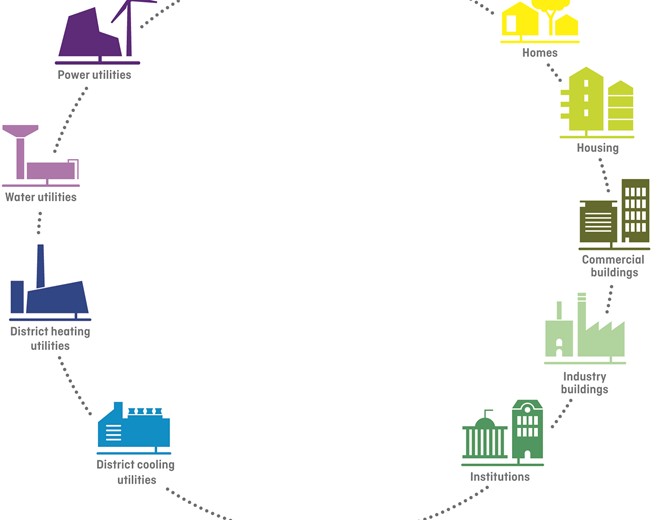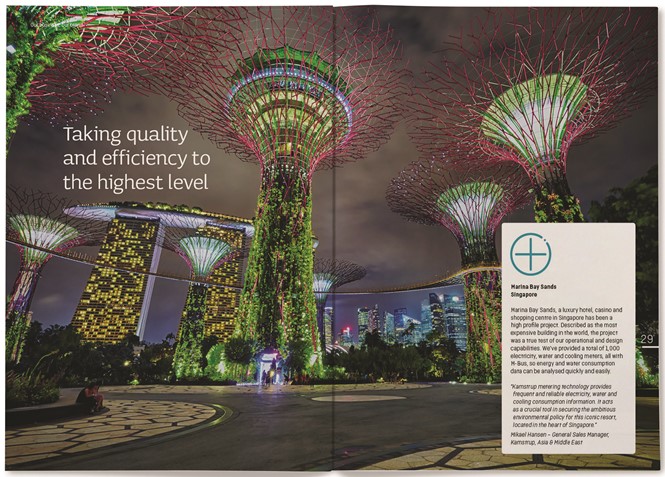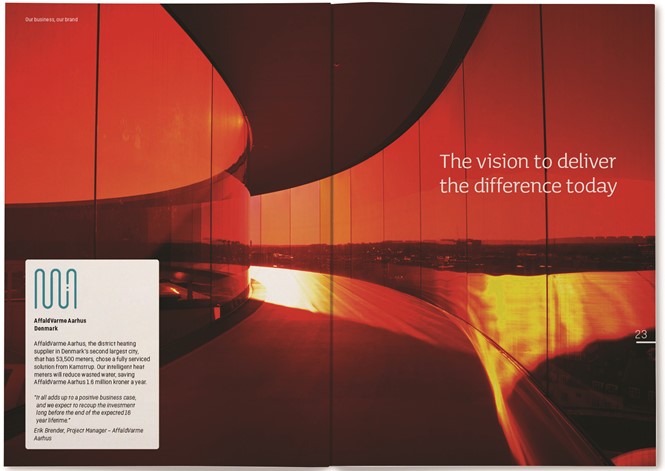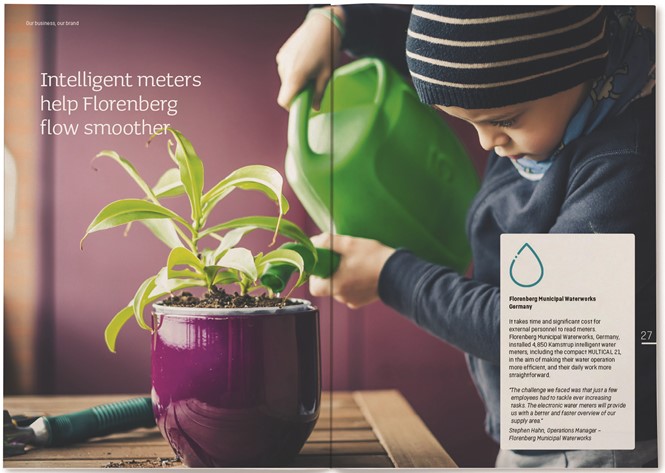Spotlight on Kamstrup
Changes in communications have forced companies that traditionally operated firmly in the B2B space into the consumer spotlight for the first time. Danish engineering company Kamstrup met that challenge head on with a graceful brand revolution. Brittany Golob reports
The word rebrand can be conflated with revolutionary change or evoke images of drastic change in terms of visual identity. Yet, it can also encompass those changes to the corporate brand that are less a revolution than an evolution. Nothing seems more fitting for a seven decades old Scandinavian engineering firm than graceful evolution.
Danish smart meter maker and engineering pioneer Kamstrup has debuted a considered, strategic brand repositioning and rebrand that lives up to both the understated Scandinavian cliché and its own history of technological change. The company, once known solely for its efficient, effective smart meters, is taking a broader look at the B2B engineering market and positioning its brand not only as a purveyor of quality products but as a leader in that landscape.
Global marketing director at Kamstrup, Jesper Daugaard, says, “The existing brand was not differentiating Kamstrup from its competitors and was not representing the modern, international and innovative company that Kamstrup has become.” He says the traditional means of marketing by word-of-mouth and product branding was not only inefficient when facing strengthened competition from lower price points but was also doing the brand a disservice in its ability to communicate with new audiences.
Yet in the process of redefining its place in the market, Kamstrup and brand consultancy Dragon Rouge set out to change the perception of smart metering in general. MD of corporate branding and communications at Dragon Rouge London, Joe Hale, says brand affinity existed for Kamstrup’s products and it was trusted by its customers, yet it was perceived as a, “dusty engineering business.” Competition from Chinese businesses offering similar products at lower prices put Kamstrup in danger of falling behind in the global race for clients and sales. The company had no point of differentiation. But Kamstrup’s tradition of innovation put it in a good position, “They’re like the Nokia phone equivalent of metering,” says Hale. “It just works.”
The biggest problem Kamstrup faced, though, was that customers only knew about the part of the company that they used. With customers like national governments, major utilities providers and large-scale retail groups, poor penetration of the brand’s message was a problem in terms of client retention and in building new relationships. Hale points to a decidedly Danish attitude toward communication – one that was understated and relied
on the value of the products to speak for themselves – as inhibiting Kamstrup’s development in this area.
Dragon Rouge worked with Kamstrup to change that to adopt a more assertive tone and illustrate the end impact the company has on customers. Daugaard says, “We created a communications framework that allowed flexibility to differentiate our message, regardless of customer type or channel. Furthermore, we created regional marketing teams that were encouraged and empowered to get closer to our local customers and understand their needs, motivations and preferences.”
The new tone of voice and brand positioning is less product-centric and focuses more on Kamstrup’s role as an energy management insights company. This shift is not unusual among B2B brands facing a world economy that is drawing closer with each passing year and competition from unexpected places. Heritage brands with strong brand loyalty and market-leading products, like Kamstrup, are often most vulnerable to this shift. Hale says, “To be credible and prospecting with potential customers, they needed to present themselves in a different way,” in a way with sophistication and intelligence. Thus, instead of competing on products, Kamstrup has turned to its true strength – it’s engineering innovation and expertise – to create a more sustainable brand.
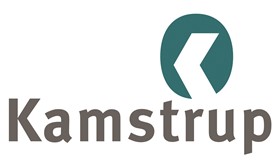

The company, once known solely for its efficient, effective smart meters, is taking a broader look at the B2B engineering market and positioning its brand not only as a purveyor of quality products but as a leader in that landscape
“The buying power is moving from being primarily a technical decision maker to a more complex set of senior business leaders,” says Daugaard. “The new value lies in helping our customers to create strategic advantage for their business and their customers.” He adds that Kamstrup’s brand promise extends beyond metering solutions to creating trust between utility companies and their consumers regarding consumption. Hale calls this a ‘future positive’ position.
The brand positioning set the tone for the rest of the rebrand process. The initial sign off, Daugaard says, was a challenge but was presented to business leaders within the context of the global brand positioning, “Having a board of directors consisting only of Danes provides a great benefit in terms of reaching consensus effectively.” Bringing Dragon Rouge on board was essential to ensuring Kamstrup’s rebrand would appeal beyond just Denmark, he adds.
The designers at Dragon Rouge noted the brand equity in Kamstrup’s simple, strong wordmark but reworked it to become more assertive. Hale says, “It was a bit apologetic for an identity of a global leader or an innovator.” The arrow icon, he adds, was facing backwards, indicating backward – not forward – momentum. Along with a new, red logo, Kamstrup was armed with a shiny new strapline – “Think Forward,” both of which indicated a more progressive business, Hale says.
Kamstrup was also armed with a new photo library, illustrative icons that are easy to implement across the business and a simpler tone of voice lending clarity to its products and communications. Photography focusing on the end user gave a human face to a perceived dusty engineering company. The iconography allowed for a simplification of the descriptions of Kamstrup’s products and services, internally and externally.
It was important for the tone of voice to both suit the company and its technically-minded employees and enhance communications with customers and with the end users of Kamstrup’s products. “If there is a mismatch between what we communicate and what our customers experience, then our credibility suffers. Our new tone of voice captures the optimism that lives inside Kamstrup,” Daugaard says. The rebrand was not just about an aesthetic shift, Hale adds, but was intended to change behaviours and attitudes to ensure sustainability of the brand.
Essentially, the shift allowed Kamstrup to sell its services, rather than its meters, Hale says. For many B2B brands, putting a clear, consumer-friendly brand on their communications has been essential in a transparent, social world. For Kamstrup, which previously had little interaction with its end users – the retail shops, homeowners or businesses in possession of its products – a consumer- friendly brand was a definite first. However, the core audience and business relationships have not been compromised by this shift. If anything, they will benefit, says Hale as Kamstrup becomes more relevant to people’s lives.
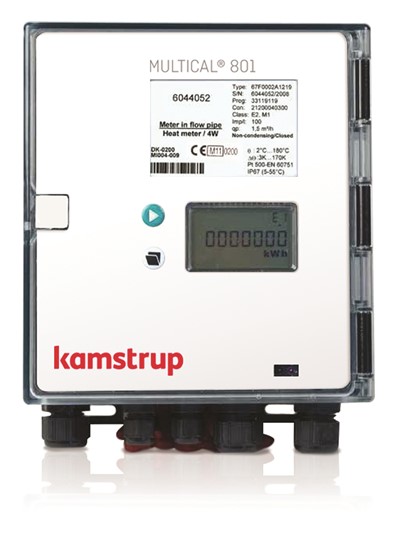
Once the digital and visual assets were developed and the brand language was decided upon, Kamstrup had to communicate about the changes to its brand internally. For a largely engineering, scientific and technical workforce, this could have been a challenging task. Kamstrup eased the transition by introducing changes gradually and by keeping its brand values similar in spirit, if not in expression, to the previous version. “What we say has to match what our customers experience. We therefore put a lot of effort into our internal launch,” Daugaard says.
Hale says the biggest challenge was in encouraging staff to change the way they wrote about Kamstrup’s products and services. “Writing like you’re a human being, not the end of a production line,” was a key focus for Dragon Rouge in developing the tone of voice. The guidelines were written as a letter, rather than an impenetrable document, to better communicate with the internal audience.
Focusing on the internal audience was also key for recruitment. With tougher competition for bright engineering and science graduates, Kamstrup’s new brand had to appeal to driven young people seeking work with an innovative, interesting company. Hale says the new brand positioning and attitude better appeals to the changing needs of those entering the workforce now.
Daugaard adds, “There’s still a long way to go as we work through the cultural changes internally, but from day one we saw this as much more than a marketing project. This is a company wide commitment to keep Kamstrup at the front of the industry.”
That commitment starts and ends with the brand’s purpose. Little has been done in terms of the design of the products themselves, intentionally. Kamstrup’s rebrand looked at the way it served its audiences whether that meant providing more efficient energy solutions, innovative technologies or simply installing smart meters. Individual products – still with strong brand loyalty among users – are no longer the story, merely the output of the company. The heart of Kamstrup is its innovation, service and technological expertise. As CEO Per Asmussen said at the outset of the project, “Technological leadership is our finest hour. We are a technology company not a manufacturer.”
Since the website launch in January, there has been a 75% increase in new business meetings and requests for information. The internal launch was a success, that resulted in Kamstrup’s 9,000-strong workforce understanding the changes and largely embracing the new ‘Inspire, Lead, Deliver’ brand values.
Peer review
Rob Ettridge, partner, Red Lorry Yellow Lorry
Whatever your view about who’s responsible for water and energy consumption – governments, utility companies or consumers – it’s become a global issue that affects us all. Utility companies and their supply chains are facing increasing competitive cost and reputation pressures. The drive to protect revenue and margins while being a good social citizen is making the utilities sector think and act. Increasingly, for suppliers, this means engaging with influencers outside of their B2B comfort zones.
Kamstrup has clearly recognised that the influencer power and buyer base is shifting. It needs to become a
more public-facing brand to support its international growth, move perceptions away from product (a meter manufacturer) to solution (‘full service provider’) and, importantly, help shape consumer awareness and trust.
The move makes sense. But more importantly the words are backed with action – new investments and acquisitions, employee engagement and more emphasis on CSR to reflect the changing focus. All too often a shiny new logo is badged as a rebrand! But it needs to go way beyond what Kamstrup says, to how it behaves and what it does.
Key to making it stick is effective internal communications – ensuring buy into and tell the new Kamstrup story consistently. They’re the real brand ambassadors. It also needs to be practical, not a fluffy marketing initiative. By bringing it to life with practical support tools – brand workshops, training programs, tone of voice and writing toolkits and posters – it’s more likely to last.
By engaging consumers to influence their energy providers, Kamstrup’s move from smart metering manufacturing to smart energy solutions is a smart one. It won’t happen overnight – especially for a global company operating in many cultures and languages – but if done well, it can have lasting reputational and bottom line benefits.

